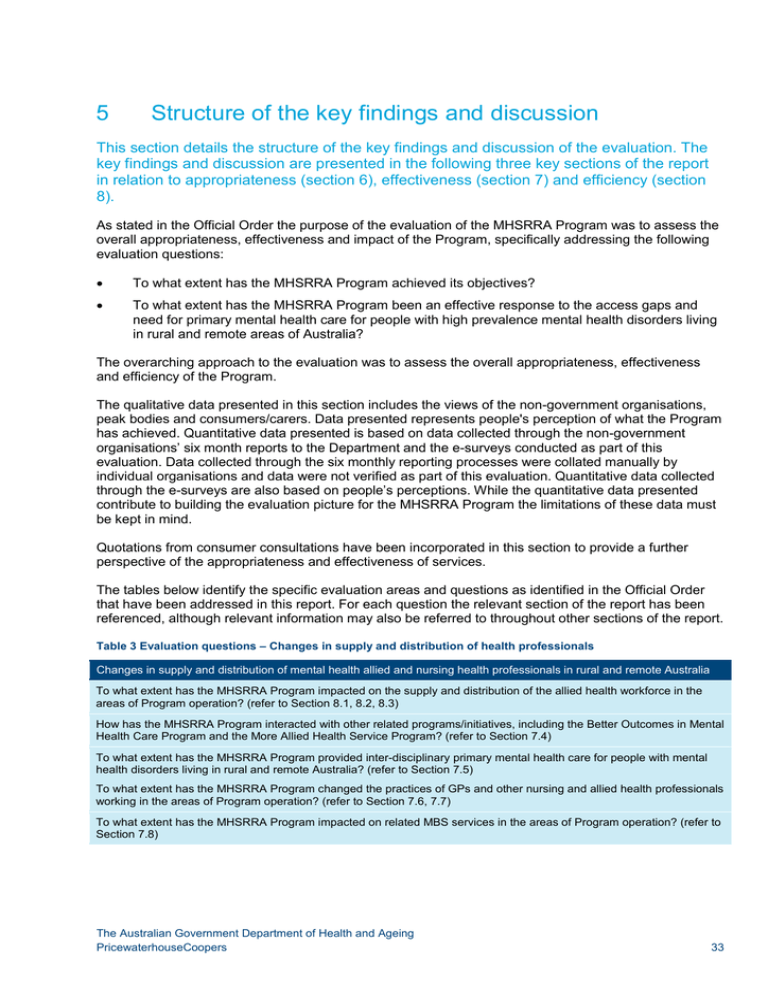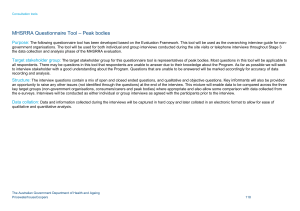5 Structure of the key findings and discussion
advertisement

5 Structure of the key findings and discussion This section details the structure of the key findings and discussion of the evaluation. The key findings and discussion are presented in the following three key sections of the report in relation to appropriateness (section 6), effectiveness (section 7) and efficiency (section 8). As stated in the Official Order the purpose of the evaluation of the MHSRRA Program was to assess the overall appropriateness, effectiveness and impact of the Program, specifically addressing the following evaluation questions: To what extent has the MHSRRA Program achieved its objectives? To what extent has the MHSRRA Program been an effective response to the access gaps and need for primary mental health care for people with high prevalence mental health disorders living in rural and remote areas of Australia? The overarching approach to the evaluation was to assess the overall appropriateness, effectiveness and efficiency of the Program. The qualitative data presented in this section includes the views of the non-government organisations, peak bodies and consumers/carers. Data presented represents people's perception of what the Program has achieved. Quantitative data presented is based on data collected through the non-government organisations’ six month reports to the Department and the e-surveys conducted as part of this evaluation. Data collected through the six monthly reporting processes were collated manually by individual organisations and data were not verified as part of this evaluation. Quantitative data collected through the e-surveys are also based on people’s perceptions. While the quantitative data presented contribute to building the evaluation picture for the MHSRRA Program the limitations of these data must be kept in mind. Quotations from consumer consultations have been incorporated in this section to provide a further perspective of the appropriateness and effectiveness of services. The tables below identify the specific evaluation areas and questions as identified in the Official Order that have been addressed in this report. For each question the relevant section of the report has been referenced, although relevant information may also be referred to throughout other sections of the report. Table 3 Evaluation questions – Changes in supply and distribution of health professionals Changes in supply and distribution of mental health allied and nursing health professionals in rural and remote Australia To what extent has the MHSRRA Program impacted on the supply and distribution of the allied health workforce in the areas of Program operation? (refer to Section 8.1, 8.2, 8.3) How has the MHSRRA Program interacted with other related programs/initiatives, including the Better Outcomes in Mental Health Care Program and the More Allied Health Service Program? (refer to Section 7.4) To what extent has the MHSRRA Program provided inter-disciplinary primary mental health care for people with mental health disorders living in rural and remote Australia? (refer to Section 7.5) To what extent has the MHSRRA Program changed the practices of GPs and other nursing and allied health professionals working in the areas of Program operation? (refer to Section 7.6, 7.7) To what extent has the MHSRRA Program impacted on related MBS services in the areas of Program operation? (refer to Section 7.8) The Australian Government Department of Health and Ageing PricewaterhouseCoopers 33 Structure of the key findings and discussion Table 4 Evaluation questions – Program uptake Program uptake To what extent has the MHSRRA Program provided access to mental health care for people with mental health disorders living in rural and remote areas of Australia? Across all age groups? Across both genders? (refer to Section 7.1) To what extent has the Program provided equitable access to populations in need? In particular children and young people; older persons; Aboriginal and Torres Strait Islander Australians; and men living in rural and remote Australia? (refer to Section 7.1) Table 5 Evaluation questions – Program implementation Program implementation relevant to patient outcomes, provision of evidence-based care and client need/expectation. To what extent has the MHSRRA Program improved mental health outcomes for people with a mental health disorder living in rural and remote Australia? (refer to Section 7.2) To what extent has the MHSRRA Program provided evidence-based mental health to people with mental health disorders living in rural and remote Australia? (refer to Section 7.3) To what extent has the MHSRRA Program provided services that match client needs and expectations? (refer to Section 6.3) Challenges During the evaluation several challenges associated with the MHSRRA Program became evident. In the main, the challenges were common across many if not all the organisations interviewed and evident within other organisations through the document review or e-survey. In particular, workforce development and support and equitable access to services, are difficult to achieve in some parts of Australia. Communities may have different priorities that rely on local knowledge and need a whole of community response. To enable this it is recognised that innovative service development and flexible models to support the provision of access to these services are paramount. These challenges have been discussed in the context of the key findings and discussion in the relevant sections of this report. The following sections present the key findings and discussion. Section 6 presents key findings and discussion in relation to appropriateness, Section 7 presents key findings and discussion in relation to effectiveness and Section 8 presents key findings and discussion in relation to efficiency. The Australian Government Department of Health and Ageing PricewaterhouseCoopers 34




